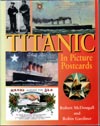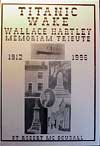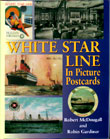|
| To Search This Site Enter Key Words Into Text Field On The Right and Hit The Search Button |
|
|
Robert McDougall.
|
McDougall, Robert. Titanic Bandmaster Remembrance BookBandmaster Remembrance Book. limited edition. privately published. 2000. wraps. Apparently limited to just four copies. isbn: none. scarcity: very scarce. With thanks to Kalman Tanito for information on this one.
|
 |
McDougall, Robert & Robin Gardiner. Titanic in Picture Postcards. 1st printing. Surrey: Ian Allan Publishing. May, 2002. hardcover. isbn: 0711028966. scarcity: fairly common.
The purpose of this book is to be a pictorial biography of the Titanic, her crew and passengers, by relating the story in pictures and words. As such the book needs to be judged both as a pictorial as well as a textual history. Unfortunately, while it mostly succeeds in the former, it fails almost completely in the latter.
The pictures include a selection of more than 200 contemporary illustrations, predominantly of postcards, from McDougall’s extensive collection. Most of the images are in black & white, but there is a nice selection of color images as well. They illustrate the short life of the ship, from her construction to launching, the maiden voyage, the tragedy and the aftermath. There is a nice selection of related images, such as White Star buildings, Titanic’s ports of call, life onboard, along with images of other ships that had a minor roll in the story.
The authors’ identification of a few of the images seems far-fetched at times. In particular is an image on page 14 which they claim is Alexander Carlisle (of Harland & Wolff), Captain Smith and J. Bruce Ismay. The identification of the latter two men as Smith and Ismay seems a real stretch to me. On page 53, they also use the now famous image supposedly depicting Titanic’s nine deck officers, which modern researchers have proven beyond a reasonable doubt is actually Captain Smith and his officers on the Olympic. Some of these men went on to serve on Titanic, but others did not. Finally, on page 112 is an image of a homemade postcard which the authors claim was made “almost certainly by a child who had lost someone in the sinking”. Unless there is some further identification on the card they do not share with the reader, I am baffled as to how they came to this conclusion.
Still, the preponderance of the images are accurately identified, and they make for a striking pictorial biography of the disaster. If only the authors had stopped there. But now we must turn our attention to the text and this is where the manure really hits the whirling blades.
Robin Gardiner has written two previous books wherein he attempted to prove that the ship that sank that night was not Titanic at all, but rather her sister ship Olympic. He believes that the two ships were switched after Olympic had sustained damage from a collision with another ship, and that White Star deliberately planned on sinking the ship, now renamed as Titanic, to collect the insurance money.
It is an absurd theory, with so many holes in it, one could sail an Olympic sized liner right through them. In his contortions to try and make this theory fit the facts, he has resorted to innuendo, misinformation, and sometimes complete fabrication of the truth. In his first book, for example Gardiner claimed that, aside from the A deck enclosing windows, Olympic & Titanic were identical. That is simply not true. They certainly looked nearly identical at a casual glance, but there were tremendous structural differences between the two. On Olympic for example there was an open promenade around the perimeter of B deck, while on Titanic, passengers cabins were built right out to the hull, doing away with the promenade on this deck.
This was a rather large discrepancy which Gardiner pretty much ignored in his first book. But in Picture Postcards, he has come up with a solution to even this seemingly insurmountable flaw in his theory. He now suggests that although Titanic’s plans showed the B deck alterations, they were never implemented and that Titanic had the B deck promenade after all.
At other points incidents are entered into the story that have little or no basis in the documented evidence. Gardiner suggests, for example, that Titanic had “a noticeable and presumably incurable list to port” during her entire maiden voyage (see pages 56 and 63). His reason for this is that, this ship was really the Olympic, of course, and Olympic had been rammed near her stern in an accident with the British warship Hawke. There are two big problems with this theory. For one, the Olympic was damaged on the starboard side, not the port side. Why would such damage to her starboard stern cause her to list permanently to port? Besides, there is no reliable testimony from crew or passengers that the ship had any such list during the voyage. Did everyone on board just not notice? Quite the opposite, the recorded testimony contains almost universal praise about the ship’s performance and stability up to the time of the disaster.
It goes on and on. The authors invent a complex conspiracy to pull off the sinking, including participation not only of White Star and her employees, but hundreds of workers at the Harland & Wolff shipyards, and Captain Stanley Lord of the Californian. The rescue ship Carpathia was apparently involved with the conspiracy as well, implying that even rival shipping firm Cunard was a party to the scam. The author claims incompetence, fraud and worse by the principal players in the drama, backing up none of these accusations with any solid evidence or supportable facts. As is typical of Gardiner’s books, there is absolutely no documentation of sources at the end of the book.
The text is so far out of line with the recorded, and documented evidence, that it sinks what would otherwise have been a splendid pictorial history into one of the most disappointing books ever printed on the subject.
|
|

|
McDougall, Robert. Titanic Wake: The Wallace Hartley Memoriam Tribute. privately printed. 1996. wraps. isbn: . scarcity: very scarce.
Cover photo courtesy of Patty Miller.
|
 |
McDougall, Robert & Robin Gardiner. White Star Line in Picture Postcards. 1st printing. Surrey: Ian Allen Publishing. September, 2003. hardcover. isbn: 0711029865. scarcity: fairly common.
With thanks to Dustin Kaczmarczyk for tipping me off about this title.
|
|
|
|
|